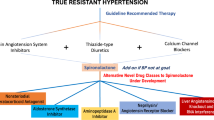Abstract
The present study aimed to investigate the influence of the angiotensin-converting enzyme (ACE)-inhibitor captopril and the Ca-antagonist nifedipine on endothelium-dependent vasodilation (EDV) in the forearm of hypertensive patients. Twenty-three middle-aged untreated hypertensive patients underwent evaluation of EDV and endothelium-independent vasodilation (EIDV) in the forearm, by means of local intra-arterial infusions of methacholine (MCh, evaluating EDV) and sodium-nitroprusside (SNP, evaluating EIDV), before and 1 h after intake of either captopril (25 mg) or nifedipine (10 mg) in a randomised, double-blind fashion. A matched normotensive control group was investigated at baseline conditions only. Five of the hypertensives were also evaluated after 3 months of treatment with captopril 25 mg twice daily in an open pilot study.
First, the vasodilation induced by methacholine (MCh), but not SNP, was significantly attenuated in the hypertensive patients compared to the normotensive controls (P < 0.001 at mch 4 μg/min).
Second, although the two drugs induced a similar decline in blood pressure (BP) 1 h after administration (−11 to 10 mm Hg/−8 to 7 mm Hg), captopril significantly potentiated the vasodilator response to MCh (+32 ± 13%, MCh 4 μg/min, P < 0.01) but not snp, while nifedipine did not significantly alter the response to either mch or snp. the improvement in vasodilator response to mch induced by captopril was closely related to the reduction in bp (r = 0.72, P < 0.01).
Third, in the pilot study, 3 months of captopril treatment induced a significant potentiation of the vasodilator response to MCh (+34 ± 17%, MCh 4 μg/min, P < 0.05) in parallel with a significant bp reduction (−22 ± 24/13 ± 13 mm hg, P < 0.05), while the response to snp was unchanged.
In conclusion, the present study confirmed that essential hypertension is associated with a defect in EDV. Furthermore, an improvement in EDV was seen in hypertensive patients shortly after administration of captopril, but not nifedipine. In addition, a significant beneficial effect on EDV was seen in a small pilot study during long-term treatment with captopril.
This is a preview of subscription content, access via your institution
Access options
Subscribe to this journal
Receive 12 digital issues and online access to articles
$119.00 per year
only $9.92 per issue
Buy this article
- Purchase on SpringerLink
- Instant access to full article PDF
Prices may be subject to local taxes which are calculated during checkout
Similar content being viewed by others
Author information
Authors and Affiliations
Rights and permissions
About this article
Cite this article
Millgård, J., Hägg, A., Sarabi, M. et al. Captopril, but not nifedipine, improves endothelium-dependent vasodilation in hypertensive patients. J Hum Hypertens 12, 511–516 (1998). https://doi.org/10.1038/sj.jhh.1000665
Received:
Accepted:
Published:
Issue date:
DOI: https://doi.org/10.1038/sj.jhh.1000665
Keywords
This article is cited by
-
Potential Protective Role of Blood Pressure-Lowering Drugs on the Balance between Hemostasis and Fibrinolysis in Hypertensive Patients at Rest and During Exercise
American Journal of Cardiovascular Drugs (2019)
-
Effect of Angiotensin-Converting Enzyme Inhibitors and Angiotensin Receptor Antagonists in Atherosclerosis Prevention
Current Cardiology Reports (2012)
-
Acute effects of renin-angiotensin system blockade on arterial function in hypertensive patients
Journal of Human Hypertension (2007)



